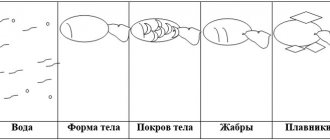Summary of educational activities for cognitive development with children of the preparatory group “Types of transport”
GCD in the preparatory group of a preschool educational institution.
Preparatory group Program objectives: 1. Develop knowledge about transport, its types 2. Develop children’s ability to distinguish between land, air and water transport.
3. Develop mental activity and attention. 5. Cultivate cognitive interest Progress:
Organizational moment. Guys, before we start our lesson, I want to invite you to solve riddles . 1. This horse does not eat oats, instead of legs there are two wheels. Sit on horseback and race on it, but it’s better to steer. (Bicycle) 2. A wonderful long house, There are many passengers in it. Wears shoes made of rubber And eats gasoline... (Bus) 3. Doesn't fly, but buzzes, A beetle runs down the street. And two brilliant lights burn in the beetle’s eyes. (Car) 4. Amazing carriage! Judge for yourself: The rails are in the air, and he holds them with his hands. (Trolleybus) 5. Well, my friend, guess, Only this is not a tram. A line of huts quickly rushes into the distance along the rails. (Train) 6. The giant lifts a lot of cargo to the clouds. Where he stands, then a new house grows. (Crane) 7. Without accelerating, it takes off high, Reminds me of a dragonfly, Sets off on a high-speed flight... (Helicopter) 8. Here is a steel bird, It strives for the skies, And its pilot leads it. What kind of bird? (Airplane) Well done, you guessed all the riddles. Now call it all in one word / Transport
Correctly, the topic of our lesson today is “Transport”
Conversation “Types of Transport” Transport can be different not only in appearance, but also in purpose, and also in the place of movement. What kind of transport do you think is called air transport? / Children's answers
Air transport is transport that moves through the air.
Name air transport / Plane, helicopter, parachute, airship, airplane, hot air balloon.
Air transport is the fastest mode of transport.
Air transport is mainly used for passenger transportation over distances of over a thousand kilometers. Freight transport is also carried out, but their share is very low. Most often, perishable products and especially valuable cargo, as well as mail, are transported by air. What kind of transport is called water transport? / Children's answers
Water transport is transport that moves on water. Name water transport. / Submarine, ship, kayak, boat, raft
Water transport is distinguished by its ability to transport very large loads.
Water transport is vital where land transportation is impossible: between continents, islands, and in poorly developed areas. The speed of water transport is relatively low, so at present it is almost never used for passenger transport. What kind of transport is called ground transport? / Children's answers
Ground transport is transport that moves on the ground. Name ground transport / Children's answers Ground transport is divided into different types of transport: trackless, road, railway
This is the most common type of transport. They use ground transport for various needs. For example, a passenger car for traveling short distances. Trains, trams, trolleybuses, electric trains are needed to transport passengers and are called public transport. Various dump trucks, trucks and Kamaz trucks are called freight transport, as they are used to transport goods. Motorcycles and bicycles are called two-wheelers and are used to travel around the area. There is also special transport, it is used by people of different professions. Such vehicles include an ambulance, a police car, a tractor, a fire truck, a garbage truck, a combine harvester, etc.
We got acquainted with different types of transport.
Now let’s see how well you can distinguish between air, water, and land transport. Didactic game "Fourth odd"
Great! Well done! Now I want to give you some homework. The teacher distributes road signs to the children.
For your next lesson, be prepared to talk about these road signs. The topic of our next lesson is “Road Safety”.
We recommend watching:
Summary of educational activities for cognitive development in the preparatory group "Journey to the North" Summary of educational activities in the preparatory group on the topic "Reservoirs" Summary of educational activities for cognition in the middle group on the topic "Transport" Summary of educational activities for speech development in the senior group on the topic: Transport
Similar articles:
Summary of a lesson in the preparatory group on the topic: Rules of conduct in kindergarten
Life safety lesson “Rules of safe behavior on water.” Preparatory group
Abstract of GCD in mathematics in the preparatory group. Counting to 11 and 12
Summary of mathematics lessons in the preparatory group. Number composition
Summary of mathematics lessons in the preparatory group. Adding and subtracting numbers
Summary of an educational lesson in a preparatory group on the topic “History of the Automobile”
Program content:
1. Strengthen children’s knowledge about modern transport.
2. Introduce children to the history of the development of road transport. 3. Systematize children’s knowledge about traffic rules and behavior on the street.
4. Develop children’s cognitive and mental activity: produce mental
operations (comparison, generalization); develop creative thinking.
5. Improve dialogic speech, enrichment and activation of vocabulary:
chariot, carriage, steam engine, “self-propelled car”, types of transport:
land, air, water, passenger, cargo, rail,
agricultural.
Material:
A panel with a set of pictures of various types of transport, drawings “History of road transport”, individual cards with a task (drawing by dots), a model of a city street, an exhibition of road transport.
Preliminary work:
1. Reading books by V. Zubkov “From Wheel to Robot”, “Machines Around Us”, “Great Discoveries”.
2. Lessons “Cave people”, “Giants of the past”, “Peasant farmstead”, “History of the wheel”.
3. Excursions along the city streets.
4. Making a “City Street” model.
Progress:
The teacher invites the children to the “transport museum”.
Listening to a tape recording (sounds and noises of the street, transport)
- What sounds and noises did you hear?
- Plane, train, cars - what is it?
— What types of transport do you know?
— What type of transport can you most often find in our city?
— Name the types of ground transport.
— In front of you is a panel and different types of transport. Find each car its place (working with panels)
-What is the difference between air transport and water transport?
What is the name of a vehicle that transports people?
What is the name of a vehicle that transports goods?
Panel truck what type of transport and why?
Machines, like people, have many different professions: loaders, postmen, orderlies, military personnel.
What are they for? Who created them?
Yes, thanks to the intelligence, talent and imagination of man, such a miracle technology was created.
Have you ever wondered if there were cars many years ago?
What did they look like?
Want to know how they came to be?
Many, many years ago, ancient people carried loads on themselves, dragged them along the ground. Then, in order to move the load, they began to place logs and push them with long poles. It was very difficult. And then man invented the wheel, which is where it all began. People built carts on solid wooden wheels. They were slowly dragged along the roads by bulls and oxen. In order to travel faster, horses began to be harnessed to the carts - and thus the chariot was born. The ancient Greeks inserted spokes into wooden wheels to make their carts lighter and faster. They rode chariots into battle, solemnly entered captured cities, and competed peacefully at the Olympic Games. But it was inconvenient to ride a chariot, because... it was unstable and could only be ridden while standing. Later, chariots were replaced by carriages. Four-wheeled, closed, they could transport many people and their things: luggage, mail. But the carriages could not travel long distances without stopping, because the horses were tired, they could not do without food and water, and people were also tired from the bumpy ride. A steam engine appeared. And the man called this unusual invention “car”, which means it moves itself – “self-propelled”. Such a car drives around the city, a copper boiler is suspended from it, and the driver sits on a bench and turns the steering wheel. It will drive a little and stop, which means the steam in the boiler has run out. No steam - the machine does not work. The driver had to get out of the car and work as a fireman - lighting the firebox and boiling water. Since then, such a driver-stoker began to be called a driver. Such a car was also inconvenient,
because was heated with wood, the boiler could explode, which created a danger for the driver and pedestrians. Therefore, the steam engine was soon replaced by the first car that had a motor and was fueled with gasoline. This car had different wheels:
two large rear wheels and one small front wheel. It could only be driven by one driver, who controlled the car using a handle. Later, the car got a roof, the wheels were made the same size, and there were four of them. For strength, the wooden wheels with spokes were covered with iron hoops, but there were no doors or glass, and they often broke. Gradually, cars began to have doors, windows,
they began to carry more passengers, but, most importantly, they put rubber inflatable tires on the wheels. Every year there were more and more gasoline cars. Their appearance changed, the design improved, the speed of movement increased, the cars became more convenient for both the driver and passengers.
Imagine that you are design engineers, creating a car of the future. What will it be like? I hope that in the future we will see such cars on our roads.
— Guys, you know that museum employees often have to unravel the secrets of ancient objects, things, paintings. It seems to me that this envelope holds some kind of secret.
Let's try to solve it? Here are encrypted pictures. (Task – connect the dots.)
Our tour of the museum has ended, and I invite you to rest.
Physical exercise.
— The continuous flow of traffic on the roads creates emergency situations. Let’s go to the “City Street” layout and see what emergency situations have arisen here. Find them.
Situations: cyclist - child entered the roadway,
a woman with a stroller crosses the street at a red traffic light,
the road sign was installed incorrectly,
a girl on roller skates clings to a moving vehicle,
children play ball on the sidewalk.
— Today we visited the “transport museum” and learned about the history of the car.



